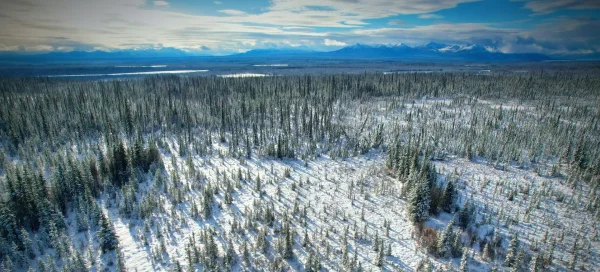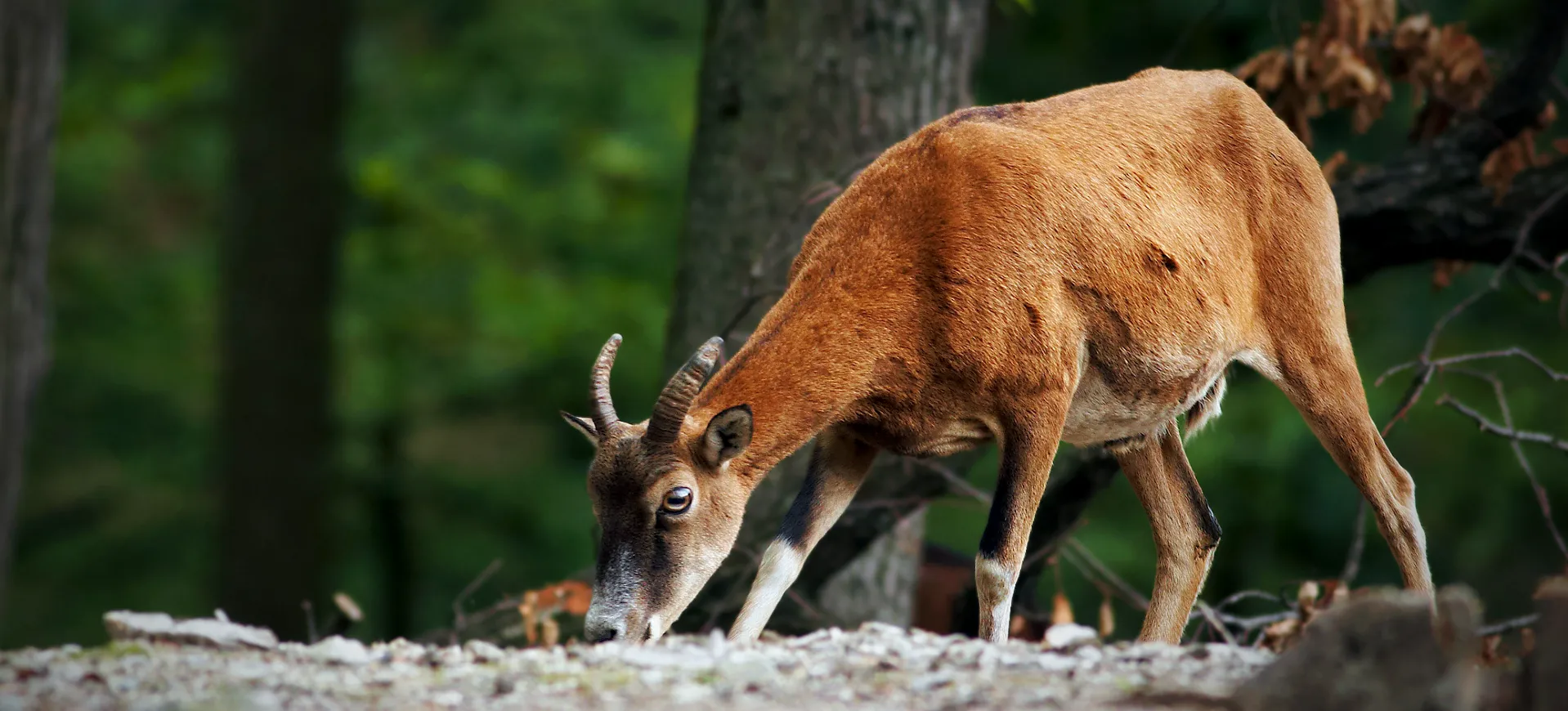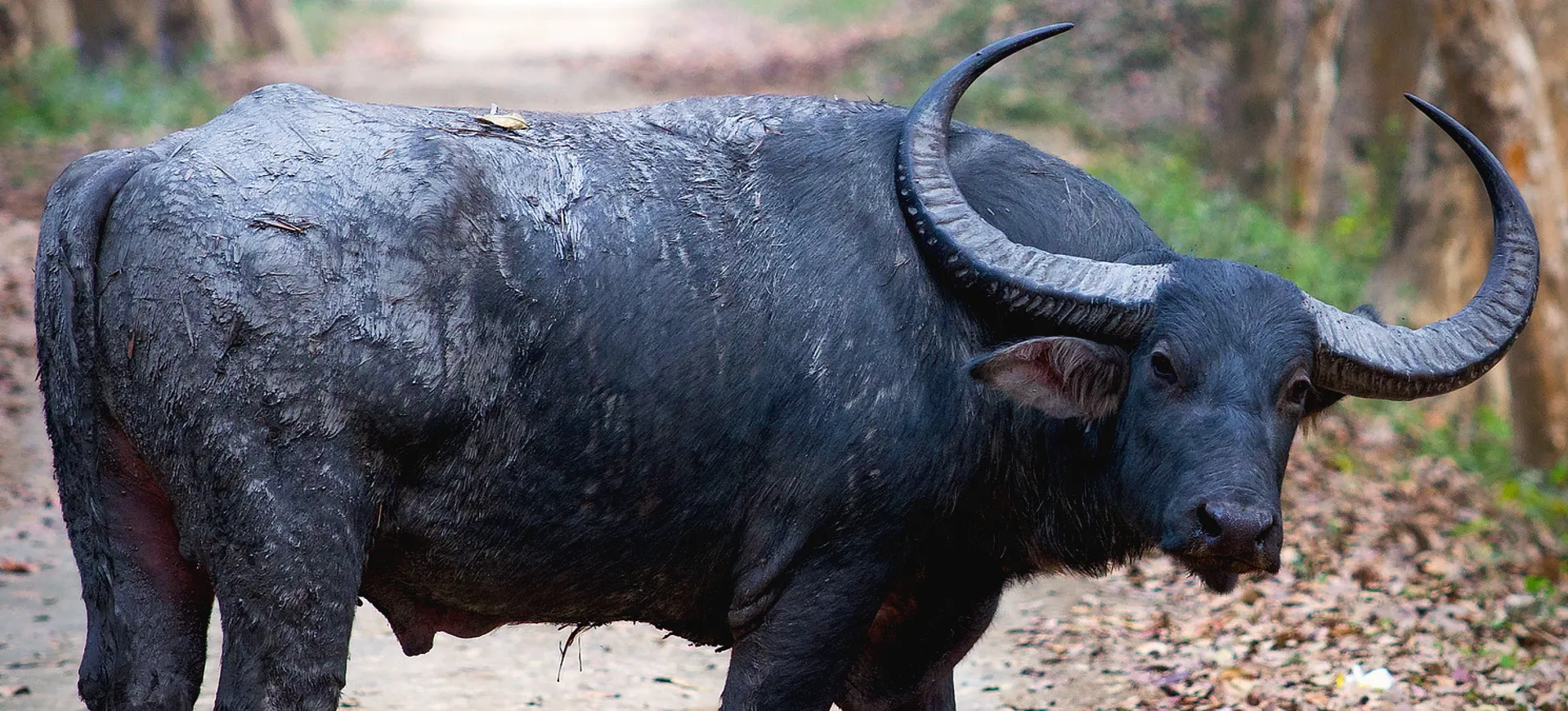Overview
The Wood Bison, a subspecies of the American bison, is the largest native terrestrial mammal in North America. Distinct from their close relative, the Plains Bison, Wood Bison are adapted to cold climates and are primarily found in Canada and Alaska’s boreal forests. They are characterized by their larger size, darker and woollier coats, and less pronounced hump compared to the Plains Bison. Historically, Wood Bison populations suffered severe declines due to overhunting and disease. Still, conservation efforts in recent decades have gradually increased their numbers, though they remain less numerous than the Plains Bison.
Wood Bison play a critical role in their ecosystems, grazing on grasses and sedges in meadows within forests, which helps maintain open spaces in these dense habitats. Their wallowing behavior creates microhabitats that other species can use, and their snow paths create trails that other wildlife utilize. The species’ recovery is considered a conservation success story, yet they continue to face threats from habitat loss, disease, and potential climate change impacts. Their social structure is similar to that of the Plains Bison, with herds typically consisting of females and their offspring, while males either remain solitary or form smaller bachelor groups.
The cultural significance of the Wood Bison is profound among Indigenous peoples in their range, who have historically relied on them for sustenance, tools, and clothing. Despite their past near-extinction, the Wood Bison stands as a symbol of wilderness and the success of dedicated conservation efforts. As a keystone species, their continued survival is essential for the health of boreal ecosystems, demonstrating the interconnectedness of species within these complex habitats.
Taxonomy
Kingdom
Phylum
Class
Order
Family
Genus
Species
Sub Species
Type
Physical Description:
Wood Bison stand out from their Plains Bison counterparts with several distinctive physical traits that have adapted them to thrive in the boreal forests’ colder, more rugged environments. Their dark, woolly coats are not just a feature of beauty but a critical adaptation that provides essential insulation against the frigid temperatures they often face. The pronounced hump on their shoulders, more prominent than that of the Plains Bison, is a reservoir of muscle and fat that supports their massive heads, allowing them to forage through deep snow to reach the grasses beneath. This physical attribute is particularly important during the long winter when food becomes scarce, and the ability to access buried vegetation is crucial for survival.
Moreover, the sheer size of the Wood Bison contributes significantly to its status as the largest terrestrial animal in North America. Adult males can tip the scales at up to 2,200 pounds, showcasing the species’ impressive physical stature. This considerable size not only deters predators but also aids in navigating their challenging habitats, from breaking trails in deep snow to asserting dominance within the herd. Females, while smaller than males, are nonetheless formidable and play a vital role in the species’ survival through their ability to navigate and endure the harsh conditions of their environments, ensuring the continuation of the species through the care of their young.

Lifespan: Wild: ~20 Years || Captivity: ~25 Years

Weight: Male: 1,800-2,200 lbs (816-998 kg) || Female: 900-1,200 lbs (408-544 kg)

Length: Male: 108-124 in (274-315 cm) || Female: 94-110 in (239-280 cm)

Height: Male: 60-73 in (152-185 cm) || Female: 54-60 in (137-152 cm)

Top Speed: 35 mph (56 km/h)
Characteristic:
Native Habitat:
Wood Bison have evolved to navigate and thrive within the challenging environments of the boreal forests and wetlands across northern Canada and Alaska. These regions, characterized by their cold climates and dense coniferous forests, provide Wood Bison’s essential resources to survive. The interspersed meadows and wetlands within these forests are crucial feeding grounds for the bison, offering a diverse menu of grasses, sedges, and herbs. This varied habitat not only supports their dietary needs but also offers shelter from harsh weather conditions and a refuge from predators, playing a vital role in the lifecycle and reproductive strategies of the species.
The conservation and preservation of boreal forest habitats are paramount for Wood Bison populations’ ongoing recovery and stability. These areas, rich in biodiversity, are under constant threat from human activities such as deforestation, oil and gas exploration, and climate change, which pose significant risks to the delicate balance of these ecosystems. Protecting these habitats through establishing protected areas and implementing sustainable management practices are crucial. Such conservation initiatives benefit the Wood Bison and support the myriad other species that share and depend on this ecosystem, underscoring the interconnected nature of biodiversity and the need for comprehensive environmental stewardship.
Climate Zones:
WWF Biomes:
Biogeographical Realms:
Continents:
Countries:
Diet:
Diet & Feeding Habits:
Wood Bison’s grazing habits are finely tuned to the seasonal food availability within the boreal forest ecosystem, showcasing their remarkable adaptability. In the warmer months, they primarily consume a diet of grasses, sedges, and herbs found in the lush meadows that dot the landscape of their forested home. However, as the harsh winter sets in and the availability of these preferred foods diminishes, they shift their diet towards willows, shrubs, and other browse types. This ability to adapt their feeding habits according to the season ensures their survival in the challenging conditions of the boreal forests, where food sources can vary greatly throughout the year.
The specialized ruminant digestive system of the Wood Bison plays a pivotal role in their survival, allowing them to extract maximum nutrition from the plant materials they consume. This complex system involves multiple stomach chambers where food is fermented, broken down, and efficiently absorbed, enabling Wood Bison to utilize the energy from tough plant fibers that many other animals cannot digest. This dietary efficiency not only supports their substantial size and energy needs but also profoundly impacts their environment. By grazing, Wood Bison influences the composition and distribution of plant species in their habitats, promoting biodiversity and aiding in the cycling of nutrients through the ecosystem. Their role as keystone species underscores the importance of their dietary habits, not just for their survival but for the health of the boreal forests they inhabit.
Mating Behavior:
Mating Description:
The rut, or mating season, for Wood Bison, is a critical time of year that dictates much of the social dynamics and hierarchy within the herd. From late July to August, this period is marked by intense competition among males, who go to great lengths to prove their dominance and suitability as mates. Their behaviors during this time include a range of displays from loud, resonant bellowing that echoes through the forest to physical confrontations such as head-to-head combat. These displays serve not only to assert individual dominance but also to attract the attention of females, who select their mates based on the outcomes of these contests. The ability of a male to secure mating rights with multiple females is a testament to his strength and genetic viability, making him a key contributor to the next generation.
Following the mating season, the gestation period for a Wood Bison cow lasts approximately 9 months, culminating in the birth of calves in the spring. These newborns are a critical addition to the herd, representing the species’ future and the previous rut’s success. Calves quickly become integral members of the herd, learning survival skills from their mothers and other adults. Their birth not only contributes to the population’s genetic diversity, essential for the species’ long-term health and resilience, but also serves as a tangible result of successful conservation efforts. As these calves grow and eventually take their places within the herd’s social hierarchy, they continue the cycle of life that has sustained Wood Bison through the challenges of the past and into the promise of the future.
Reproduction Season:
Birth Type:
Pregnancy Duration:
Female Name:
Male Name:
Baby Name:
Social Structure Description:
The social dynamics of Wood Bison herds are intricate and pivotal for the well-being and continuity of the species. Within the herd, females and their offspring form cohesive groups central to the herd’s structure, providing safety in numbers and facilitating knowledge sharing, such as the locations of the best foraging spots or water sources. Conversely, males may lead more solitary lives or form smaller, less stable groups, especially outside of the mating season. These social configurations allow the Wood Bison to effectively utilize their habitat, adapting to seasonal changes and minimizing the impact of predators. The variation in herd size and composition directly reflects the environmental conditions, including the quality of the habitat and the degree of human disturbance, which can disrupt their natural behaviors and habitat use.
During the rut, the herd’s social structure becomes particularly pronounced as males compete to mate through displays of strength and dominance. This period is marked by intense male interactions, including vocalizations, physical confrontations, and other behaviors to establish a hierarchy. Such social hierarchies are crucial for reproductive success, ensuring that only the strongest and most fit males contribute to the gene pool. The establishment of dominance determines mating rights and reinforces the herd’s social order, contributing to its overall stability and resilience. This complex social organization supports efficient foraging, enhances the herd’s ability to avoid predators, and ensures the successful rearing of offspring, thereby playing a vital role in the survival and reproductive success of the Wood Bison.
Groups:
Conservation Status:
Population Trend:
The conservation journey of the Wood Bison, from the brink of extinction to a path toward recovery, is a testament to the impact of dedicated conservation work. With populations once dwindling to fewer than 300 individuals due to overhunting and disease, concerted efforts over the past few decades have begun to reverse their decline. These efforts have been multi-faceted, involving the establishment of protected areas where bison can roam without the immediate threats of human encroachment, the implementation of health monitoring and vaccination programs to control diseases like tuberculosis and brucellosis, and the management of genetic diversity to ensure healthy, resilient herds. Such strategic approaches have stabilized existing populations and laid the groundwork for successful reintroduction into areas where the Wood Bison had previously been extirpated.
Despite these successes, the current Wood Bison population still represents only a small fraction of the numbers that once traversed the North American boreal forests. This reality underscores the importance of not becoming complacent in conservation efforts. The positive trend in their population growth demonstrates the species’ potential for further recovery, serving as a beacon of hope for conservationists and wildlife enthusiasts alike. It highlights the critical need for ongoing conservation initiatives, including habitat preservation, continued disease management, and the expansion of reintroduction programs. Such sustained efforts are essential to maintain the gains achieved thus far and expand the Wood Bison’s range and numbers, moving closer to restoring the ecological balance of their native habitats.
Population Threats:
Wood Bison face many threats that jeopardize their survival and hinder the progress of conservation efforts aimed at their recovery. Habitat loss is one of the most formidable challenges, with extensive areas of boreal forest and wetlands being transformed due to activities like logging, oil and gas extraction, and the encroachment of agriculture. These changes not only diminish the available space for Wood Bison to roam but also impact the quality of their habitat, affecting the availability of essential food sources and the integrity of their environment. Climate change compounds these issues, altering precipitation patterns and temperature regimes, which can lead to changes in habitat composition and availability, further stressing the already vulnerable bison populations.
In addition to habitat concerns, disease transmission from domestic livestock to Wood Bison populations presents a persistent threat. Diseases such as bovine tuberculosis and brucellosis can have devastating effects on bison herds, leading to poor health, reduced reproductive success, and, in some cases, significant mortality. The expansion of human infrastructure, including road construction, further exacerbates the plight of the Wood Bison by fragmenting their habitats and increasing the likelihood of vehicle collisions, a direct threat to their survival. These challenges underscore the critical need for comprehensive conservation strategies that address not only the protection and restoration of habitat but also disease management and the mitigation of human-wildlife conflicts. Such strategies are essential to ensure Wood Bison populations’ long-term survival and recovery across their historical range.
Conservation Efforts:
The multifaceted approach to Wood Bison conservation has yielded positive outcomes, underscoring the importance of habitat protection, disease management, and genetic diversity. Protecting the Wood Bison’s natural habitats from further degradation and loss is foundational to their survival, ensuring they have the necessary space and resources to thrive. Disease management initiatives, including vaccination programs and monitoring of wildlife health, have been critical in mitigating the impact of diseases such as bovine tuberculosis and brucellosis, which can devastate populations. Moreover, reintroduction programs have been pivotal in re-establishing Wood Bison in parts of their historical range, carefully maintaining genetic diversity and enhancing population resilience, thus contributing to the species’ long-term viability.
Collaboration has been a cornerstone of these conservation efforts, bringing together a diverse array of stakeholders to champion the cause of the Wood Bison. Government agencies, Indigenous communities, and conservation organizations have worked in tandem, leveraging a combination of traditional knowledge and scientific research to develop and implement effective management strategies. This cooperative approach fosters mutual respect and understanding and enriches the conservation strategies with a broad spectrum of perspectives and expertise. Additionally, growing public awareness and support have amplified the call for the Wood Bison’s protection, highlighting its ecological and cultural significance. This increasing public engagement is a promising sign for the future of Wood Bison conservation, as it strengthens the collective resolve to secure a stable and thriving future for this majestic species.
Additional Resources:
Fun Facts
- Wood Bison are the heaviest land animals in North America, with adult males weighing up to 2,200 pounds.
- Their thick, woolly coats are adapted for the cold temperatures of the boreal forests, providing significant insulation.
- Wood Bison significantly impact their ecosystems, creating wallows that benefit other species and shaping vegetation through grazing.
- They were nearly extinct in the early 20th century but have rebounded due to conservation efforts.
- Following ancient migration routes, Wood Bison herds can travel long distances for food.
- Their hooves are adapted to their wetland habitats, helping them traverse muddy areas without sinking.
- Calves are born with a reddish coat that darkens as they mature.
- Wood Bison play a crucial role in Indigenous cultures, providing materials for clothing, tools, and ceremonial items.
- They have a lower center of gravity than Plains Bison, which helps them navigate deep snow.
- The successful reintroduction of Wood Bison into Alaska is considered a significant achievement in wildlife conservation.















































































